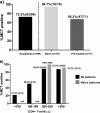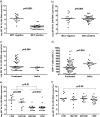Virological response after short-term CCR5 antagonist exposure in HIV-infected patients: frequency of subjects with virological response and associated factors
- PMID: 21807977
- PMCID: PMC3187011
- DOI: 10.1128/AAC.00753-11
Virological response after short-term CCR5 antagonist exposure in HIV-infected patients: frequency of subjects with virological response and associated factors
Abstract
The virological response after an 8-day maraviroc monotherapy has been proposed to be an alternative method to determine whether an CCR5 antagonist should be prescribed to HIV-infected patients. The frequency of patients eligible for a combined antiretroviral therapy which includes maraviroc on the basis of the result of this clinical test is not well-known at the moment. In the same way, clinical and immunovirological factors associated with the virological response after antagonist exposure need to be determined. Ninety consecutive HIV-infected patients were exposed to an 8-day maraviroc monotherapy. The virological response was considered positive if either a reduction of ≥1-log(10) HIV RNA copies/ml or an undetectable viral load (<40 HIV RNA copies/ml) was achieved. CXCR4- and CCR5-tropic virus levels were determined by using patients' viral isolates and multiple rounds of infection of indicator cell lines (U87-CXCR4 and U87-CCR5). The frequency of patients with a positive virological response was 72.2% (94.7% and 66.2% for treatment-naïve and pretreated patients, respectively). The positive response rates dramatically decreased in patients with lower CD4(+) T-cell counts. The CXCR4-tropic virus level was the only variable independently associated with the virological response after short-term maraviroc exposure. Lower CD4(+) T-cell strata were associated with higher CXCR4-tropic virus levels. These results support the suggestion that CCR5 antagonists should be an early treatment option before the expansion of CXCR4-tropic strains.
Figures


Similar articles
-
Virological and immunological response to antiretroviral regimens containing maraviroc in HIV type 1-infected patients in clinical practice: role of different tropism testing results and of concomitant treatments.AIDS Res Hum Retroviruses. 2014 Jan;30(1):17-24. doi: 10.1089/AID.2012.0235. Epub 2013 Sep 17. AIDS Res Hum Retroviruses. 2014. PMID: 23971941 Free PMC article.
-
Emergence of CXCR4-using human immunodeficiency virus type 1 (HIV-1) variants in a minority of HIV-1-infected patients following treatment with the CCR5 antagonist maraviroc is from a pretreatment CXCR4-using virus reservoir.J Virol. 2006 May;80(10):4909-20. doi: 10.1128/JVI.80.10.4909-4920.2006. J Virol. 2006. PMID: 16641282 Free PMC article. Clinical Trial.
-
HIV-1 tropism evolution after short-term maraviroc monotherapy in HIV-1-infected patients.Antimicrob Agents Chemother. 2012 Jul;56(7):3981-3. doi: 10.1128/AAC.00507-12. Epub 2012 Apr 30. Antimicrob Agents Chemother. 2012. PMID: 22547624 Free PMC article. Clinical Trial.
-
Maraviroc: a review of its use in the management of CCR5-tropic HIV-1 infection.Drugs. 2010 Jun 18;70(9):1189-213. doi: 10.2165/11203940-000000000-00000. Drugs. 2010. PMID: 20518583 Review.
-
Maraviroc: a CCR5-receptor antagonist for the treatment of HIV-1 infection.Clin Ther. 2008 Jul;30(7):1228-50. doi: 10.1016/s0149-2918(08)80048-3. Clin Ther. 2008. PMID: 18691983 Review.
Cited by
-
The role of genetic variants of Stromal cell-Derived Factor 1 in pediatric HIV-1 infection and disease progression.PLoS One. 2012;7(9):e44460. doi: 10.1371/journal.pone.0044460. Epub 2012 Sep 4. PLoS One. 2012. PMID: 22962615 Free PMC article.
-
Validation of the HIV Tropism Test TROCAI Using the Virological Response to a Short-Term Maraviroc Monotherapy Exposure.Antimicrob Agents Chemother. 2016 Sep 23;60(10):6398-401. doi: 10.1128/AAC.01326-16. Print 2016 Oct. Antimicrob Agents Chemother. 2016. PMID: 27480849 Free PMC article.
-
Reduced Baseline Sensitivity to Maraviroc Inhibition Among R5 HIV-1 Isolates From Individuals With Severe Immunodeficiency.J Acquir Immune Defic Syndr. 2016 Mar 1;71(3):e79-82. doi: 10.1097/QAI.0000000000000873. J Acquir Immune Defic Syndr. 2016. PMID: 26492461 Free PMC article.
-
Virological and immunological response to antiretroviral regimens containing maraviroc in HIV type 1-infected patients in clinical practice: role of different tropism testing results and of concomitant treatments.AIDS Res Hum Retroviruses. 2014 Jan;30(1):17-24. doi: 10.1089/AID.2012.0235. Epub 2013 Sep 17. AIDS Res Hum Retroviruses. 2014. PMID: 23971941 Free PMC article.
-
Effect of maraviroc on HIV disease progression-related biomarkers.Antimicrob Agents Chemother. 2012 Nov;56(11):5858-64. doi: 10.1128/AAC.01406-12. Epub 2012 Sep 4. Antimicrob Agents Chemother. 2012. PMID: 22948867 Free PMC article.
References
-
- Berger E. A., et al. 1998. A new classification for HIV-1. Nature 391:240. - PubMed
-
- Chueca N., et al. 2009. Improvement in the determination of HIV-1 tropism using the V3 gene sequence and a combination of bioinformatic tools. J. Med. Virol. 81:763–767 - PubMed
-
- Cooper D. A., et al. 2010. Maraviroc versus efavirenz, both in combination with zidovudine-lamivudine, for the treatment of antiretroviral-naive subjects with CCR5-tropic HIV-1 infection. J. Infect. Dis. 201:803–813 - PubMed
-
- Fiser A. L., et al. 21 September 2010, posting date High CD4+ T-cell surface CXCR4 density as a risk factor for R5 to X4 switch in the course of HIV-1 infection. J. Acquir. Immune Defic. Syndr. [Epub ahead of print.] - PubMed
Publication types
MeSH terms
Substances
LinkOut - more resources
Full Text Sources
Other Literature Sources
Medical
Research Materials

